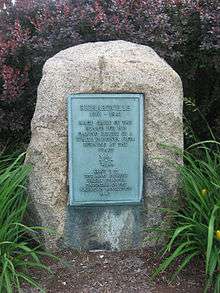Jean Baptiste Richardville


Jean Baptiste de Richardville (c. 1761 – 13 August 1841), known as Pinšiwa in Miami (meaning Wildcat, also spelled Peshewa) and John Richardville, was the last akima (civil chief) of the Miami people.[1] He was a signatory to the Treaty of Greenville (1795) and later treaties with the United States through the Treaty of Mississinwas (1826). A fur trader who controlled an important portage connecting the Maumee River to the Little River, by his death in 1841 he was considered the wealthiest man in Indiana. He had acquired more than 20 square miles of property along the rivers.
In 1827 he completed construction of a treaty house partially funded by the United States. The Richardville House is the first in northeastern Indiana to be built in the Greek Revival style, the oldest Native American house in the state, and one of the few surviving treaty houses in the United States. It was designated in 2012 as a National Historic Landmark.
Biography
Jean Baptiste de Richardville was born about 1761 in the Miami (Myaami) village of Kekionga (present-day Fort Wayne, Indiana), son of Tacumwah, sister of the Miami chief Pacanne, and Joseph Drouet de Richerville, a French fur trader from Quebec. The boy was well educated, and learned to speak Miami, an Algonquian language; Iroquois, French, and English. He gained his status in the tribe from his mother's people, as it had a matrilineal system. As an adult, Peshewa later refused to speak white/European languages or wear European-style clothing.[2]
Richardville and his mother made most of their income from the fur trade and control of a portage connecting the Maumee River to the Little River, known today as the Little Wabash River. The Northwest Ordinance of the United States Congress declared that all important portages in the region were to be free for use. The Miami lost control of the portage in the Treaty of Greenville (1795), which ended the Northwest Wars by which a coalition of Native Americans had tried to repulse the European Americans from the region west of the Appalachians and north of the Ohio River.
But, Richardville acquired a trade license in 1815 which gave him a monopoly on carry-over services at the portage. He earned considerable profits again from trading traffic at the portage.[3]
In 1818, Richardville signed the Treaty of St. Mary's with the US. The treaty punished the Miami for their lack of support to the US during its War of 1812 against the British, and forced them to cede most of their land in central Indiana to the United States.[4] At the time, Richardville negotiated legal land grants in the area to individual Miami families, including for himself. He eventually controlled more than 20 square miles along the St. Joseph, St. Mary's, Mississinewa, Salamonie and Wabash rivers.[5]
Pinšiwa often offered his private lands as a refuge for other Miami. This enabled about half of the Miami people to remain in Indiana when the tribe was officially removed by the US in 1846 to Indian Territory west of the Mississippi River, five years after Richardville died.[6]
After signing the Treaty of Mississinwas (1826), Richardville was given $600 by the United States toward building the Richardville House in present-day Fort Wayne, where he lived the rest of his life. Richardville used his own funds for the remainder of the total estimated cost at the time of $2200 to build the house; when completed in 1827, it was the first Greek Revival-style house in northeastern Indiana.[5]
At the time of his death in 1841, Richardville is considered to have been the richest man in the state of Indiana. He was succeeded as chief by his eldest daughter's husband, Francis La Fontaine.[7] The Richardville House remained in the family until 1894. It was then acquired by a gravel company that mined all but about an acre surrounding the house. The structure was designated a National Historic Landmark in 2012, as it is one of the few surviving treaty houses and the oldest Native American house in the Midwest.
In 1991, the house was acquired by the Allen County-Fort Wayne Historical Society. It has restored the exterior, opens the house monthly during the summer season for visitors, and operates a variety of programs on Miami history at the site.
Legacy and honors
- Richardville County, Indiana was named for him. (It was later renamed as Howard County.)
- Wildcat Creek (Indiana) , whose watershed encompasses Howard and another county, was named for him.
References
- ↑ "America's Great Outdoors: Secretary Salazar Designates Thirteen New National Historic Landmarks". US Department of the Interior. 6 March 2012. Retrieved 25 March 2012.
- ↑ Anson, p. 189
- ↑ Poinsatte, 79-80
- ↑ Carter, p. 242
- 1 2 "Chief Richardville House", History Center, Allen County-Fort Wayne Historical Society, accessed 26 March 2012
- ↑ Carter, p. 243">Carter, p. 243
- ↑ Carter, p. 243
- Anson, Bert. The Miami Indians, 2000, University of Oklahoma Press. ISBN 0-8061-3197-7.
- Carter, Harvey Lewis. The Life and Times of Little Turtle: First Sagamore of the Wabash, 1987, Urbana: University of Illinois Press. ISBN 0-252-01318-2.
- Edmunds, R. David. "Jean Baptiste Richardville," Encyclopedia of North American Indians, 549–550. Ed. Frederick E. Hoxie. Boston: Houghton Mifflin, 1996. ISBN 0-395-66921-9.
- Poinsatte, Charles (1976). Outpost in the Wilderness: Fort Wayne, 1706-1828. Allen County, Fort Wayne Historical Society.
- Durand, Bruno. "Les Drouet de Richarville, colons du Québec et de l'Amérique," Bulletin de la Société Historique de Dourdan (France), n° 46 (dec 2003) pp. 3 to 29. ISSN 0248-9392.
External links
- Chief Richardville House, Fort Wayne History Center
- "Jean Baptiste Richardville House", Around Fort Wayne, Team Schaefer, video on YouTube
- Forks of the Wabash, Historic Forks